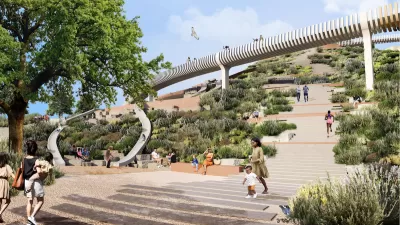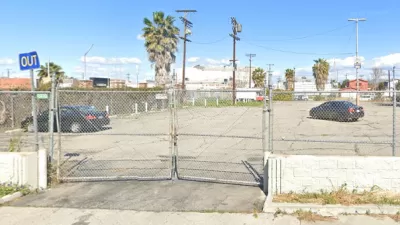Robbie Whelan reports that the last remaining unbuilt parcel in L.A.'s 1,000-acre Playa Vista development has been sold to Brookfield Homes, reflecting a turn by developers away from the exurbs and towards densifying urban cores.
Whelan details Brookfield's plans to develop the 110-acre site in Playa Vista as "600 to 800 homes, 1,500 apartment units, and a downtown-like 'village' that includes a supermarket, movie theater, and office buildings." As he notes, the project reflects a focus by builders in Los Angeles and throughout the country on projects in 'greyfield' and 'brownfield' sites in developed areas, rather than 'greenfield' sites at the fringe of urban areas, as land use patterns that were the norm pre-recession get rethought.
"Developments like these—smaller home groupings, mixed with commercial uses and wedged between urban areas—are becoming more popular partly because of changing ideas about land-use planning in places like coastal California," says Whelan. "During the housing boom of the last decade, builders’ mantra was 'Drive till you qualify'—a slogan that described a business strategy of slapping up hundreds of cheap homes on inexpensive land far from city centers. If buyers went far enough into the suburbs, they could eventually qualify for a mortgage."
"But developers today are looking more for “infill” locations like Playa Vista. 'It’s an attempt to push growth back into urban cores,' says Michael Lea, a professor of real-estate finance at San Diego State University."
This trend is not limited to Southern California, however. Whelan points out that, "[b]uilders are targeting infill projects in other parts of the country as well. PulteGroup, a Bloomfield Hills, Mich.-based builder, has recently focused on opening communities with between 30 and 100 homes in markets like Chicago and Minneapolis. The company has traditionally concentrated on large tracts in the suburbs."
“When we were in growth mode, we probably would have passed on a 45-unit project,” says Patrick Beirne, Pulte’s president for the region that includes the Midwest. “But before, we were targeting entry-level buyers and very young families, and a lot of that was in the outskirt locations.”
FULL STORY: Playa Vista ‘Fills’ Up

Planetizen Federal Action Tracker
A weekly monitor of how Trump’s orders and actions are impacting planners and planning in America.

Restaurant Patios Were a Pandemic Win — Why Were They so Hard to Keep?
Social distancing requirements and changes in travel patterns prompted cities to pilot new uses for street and sidewalk space. Then it got complicated.

Map: Where Senate Republicans Want to Sell Your Public Lands
For public land advocates, the Senate Republicans’ proposal to sell millions of acres of public land in the West is “the biggest fight of their careers.”

Maui's Vacation Rental Debate Turns Ugly
Verbal attacks, misinformation campaigns and fistfights plague a high-stakes debate to convert thousands of vacation rentals into long-term housing.

San Francisco Suspends Traffic Calming Amidst Record Deaths
Citing “a challenging fiscal landscape,” the city will cease the program on the heels of 42 traffic deaths, including 24 pedestrians.

California Homeless Arrests, Citations Spike After Ruling
An investigation reveals that anti-homeless actions increased up to 500% after Grants Pass v. Johnson — even in cities claiming no policy change.
Urban Design for Planners 1: Software Tools
This six-course series explores essential urban design concepts using open source software and equips planners with the tools they need to participate fully in the urban design process.
Planning for Universal Design
Learn the tools for implementing Universal Design in planning regulations.
Heyer Gruel & Associates PA
JM Goldson LLC
Custer County Colorado
City of Camden Redevelopment Agency
City of Astoria
Transportation Research & Education Center (TREC) at Portland State University
Camden Redevelopment Agency
City of Claremont
Municipality of Princeton (NJ)





























